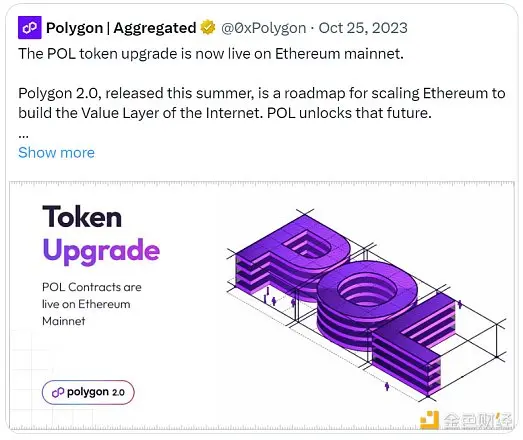What changes will the upgrade from MATIC to POL bring? What are the implications?
Original source: hitesh.eth X account
Author: hitesh.eth, crypto KOL
Compiled by: Jinse Finance xiaozou
What changes will occur in the token economics after MATIC upgrades to POL, and what impact will it have on the future value of the POL token? In this article, we will explore this together.
Polygon announced two major plans in its roadmap last year. The first plan is to upgrade the Polygon PoS chain to the ZkEVM Validum chain for higher scalability and faster finality, while connecting to AggLayer. The second plan is to launch the POL token through a 1:1 migration of MATIC to POL tokens.

Starting from September 4, 2024, holders can migrate their MATIC 1:1 to the new POL token. CEXs (centralized exchanges) like Binance and OKX will handle the migration on behalf of users.
You just need to follow their announcements, cancel all open orders, and if you hold MATIC, you will receive POL tokens.

Some DEXs (decentralized exchanges) and DEX aggregation platforms will use their own UI for the migration from MATIC to POL, and you can also use the Polygon migration portal or smart contract address to complete this migration yourself.
Interestingly, the token upgrade also brings significant changes to the token economics, with design considerations that cover future roadmaps and value capture.

What changes does it bring?
The inflation rewards for Matic tokens held by Polygon validators ended last year after Polygon completed its inflation cycle.
We all know how difficult it is to maintain network growth without token rewards, so they need to address this issue to keep the network running smoothly and maintain the enthusiasm of validators.
Each year, 200 million new POL tokens will be put into circulation as rewards for validators over the next 10 years. If 1 POL = $0.5, then the value of these 200 million tokens is equivalent to $100 million.
This is the standard reward they will receive, but Polygon also offers some additional incentives to encourage them to play more roles in supporting other chains.
Polygon has established an L2 creation tech stack, and they have also built a unified liquidity layer called AggLayer, which will help L2s provide ample liquidity for their ecosystems through the Polygon network.

The idea here is straightforward: as a staker, you will delegate your stake to validators, who will mint tokens through the inflation cycle. They will earn fee revenue from aggregators and will also receive additional token rewards from the CDK chain, which is part of the Polygon network.

Rewards are divided into two types:
- CDK chain token rewards for stakers
- Sharing the fee revenue from AggLayer with stakers
More forms of rewards are in preparation:
- Shared sorting revenue
- Zero-knowledge proof revenue, etc……
This is like a validator payment network, encouraging them to play multiple roles at different times.

We have discussed the basics of the new token economics.
Demand side of the token:
I think this is very simple—this will be a demand driven by staking. There are only about 33,000 MATIC holders participating in staking, and due to the lack of rewards, the overall staking rate has been low recently.

The current staking yield is around 5.65%, which is better than ETH but lower than Solana and Avalanche. After the POL migration and the activation of the new inflation policy, the yield should rise to 7-8%, and as AggLayer and CDK gain more adoption, the yield may continue to increase.

Ultimately, the best-case scenario is that those POL stakers begin to receive additional token rewards in the form of airdrops, similar to Celestia… The likelihood of this happening is also quite high.
There are already more than a dozen well-funded projects on AggLayer that may conduct some airdrops at the right time.

Such actions will drive the formation of FOMO and may increase the number of stakers from 33,000 to at least 100,000. Celestia has 400,000 stakers, from which you can see the potential for increased staking demand.
Overall, I believe this is a good time for the MATIC token upgrade. With Polygon's overall technology deployment, they can drive more demand for the token by establishing more partnerships on their key infrastructure product (AggLayer).










